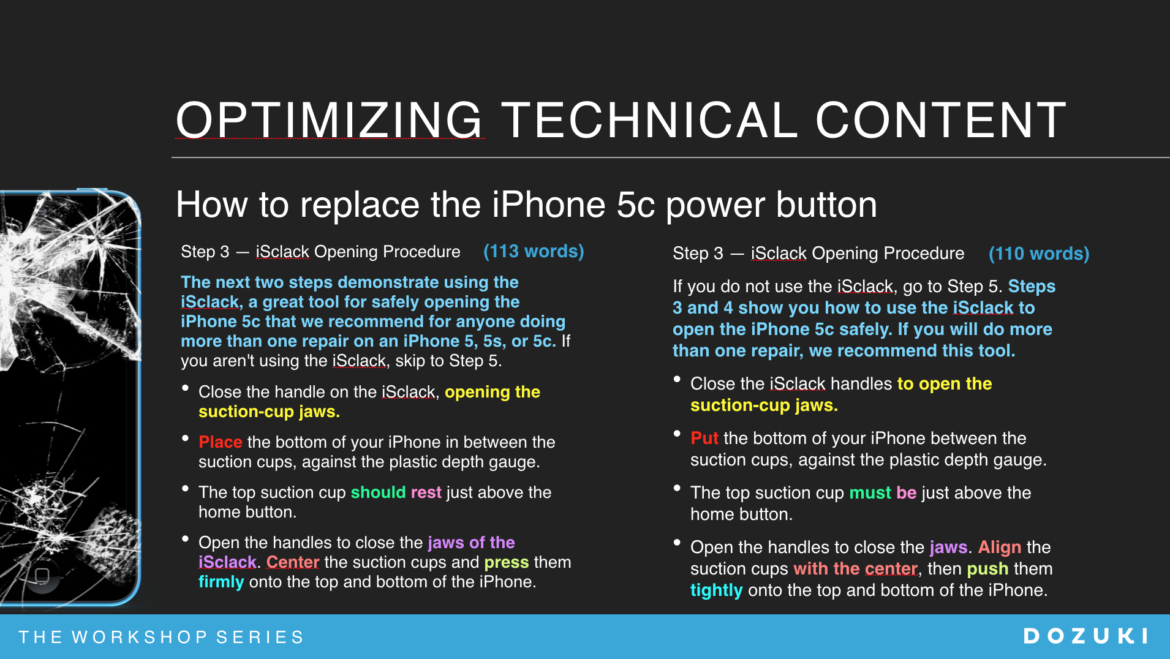August 2016
Dozuki Workshop Series – Optimize your technical content (Part 2 of 3)
Read Part 1 of our blog series here:
Dozuki Workshop Series – Optimize your technical content (Part 1 of 3)
A precise, coherent and audience-oriented technical content delivery is what every professional technical communicator should aim for, and standardising your terminology and documents at the word, phrase, and sentence levels is the first step to take.
In part two of our three-part text analysis, we will continue to share more examples of how you can prepare your content for optimum re-use, readability, and translatability. We will highlight areas for improvement, then provide the same information based on Simplified Technical English (STE) writing rules.
RULE: 5.1 Keep procedural sentences as short as possible.
1a) Standard English:
The next two steps demonstrate using the iSclack, a great tool for safely opening the iPhone 5c that we recommend for anyone doing more than one repair on an iPhone 5, 5s, or 5c. If you aren’t using the iSclack, skip to Step 5.
1b) STE:
If you do not use the iSclack, go to Step 5. Steps 3 and 4 show you how to use the iSclack to open the iPhone 5c safely. If you will do more than one repair, we recommend this tool.
Analysis:
In this rewrite, we advise users to skip the next two steps immediately if they do not use the iSclack. Also, shorter instructions that inform the user what specific actions to complete are easier to process. Procedural sentences in STE should ideally stay within the 20-word limit.
RULE: 3.3 Use the approved forms of the verb to make only:
– The infinitive (to open..)
– The imperative (Open the..)
– The past participle as an adjective (the opened valve)
– The simple present tense (it opens)
– The simple past tense (it opened)
– The future tense (you will open..).
2a) Standard English:
- Close the handle on the iSclack, opening the suction-cup jaws.
2b) STE:
- Close the iSclack handles to open the suction-cup jaws.
Analysis:
The present participle or verbs ending in -ing are not used in STE unless they are part of a technical name. Some examples include: during, lighting, missing, routing, and servicing.
RULE: 1.1 Only use approved words in the dictionary
3a) Standard English:
- Place the bottom of your iPhone in between the suction cups, against the plastic depth gauge.
- The top suction cup should rest just above the home button.
- Open the handles to close the jaws of the iSclack. Center the suction cups and press them firmly onto the top and bottom of the iPhone.
3b) STE:
- Put the bottom of your iPhone between the suction cups, against the plastic depth gauge.
- The top suction cup must be just above the home button.
- Open the handles to close the jaws. Align the suction cups with the center, then push them tightly onto the top and bottom of the iPhone.
Analysis:
Use ‘put‘ instead of ‘place’, ‘must‘ instead of ‘should’, ‘push‘ instead of ‘press’, and ‘tightly‘ instead of ‘firmly’. ‘Center‘ is an approved STE word, but only as a technical noun. Ergo, it is necessary to rewrite this clause to: ‘Align the suction cups with the centre,..’.
The STE general vocabulary or dictionary offers technical writers approved synonyms for non-approved words. This is going to be very helpful for the writer who is transitioning from Standard English to Simplified Technical English.
Further reading: Dozuki Workshop Series – Optimize your technical content (Part 3 of 3)
Missed this session? The on-demand presentation is now available below.
About the speaker
Since 2006, Ms Shumin Chen has been working as a consultant with customers in various industries worldwide: aerospace and defence, banking, consumer products, healthcare, IT, medical and fitness equipment. She has helped many companies with their documentation needs, based on standards where possible, and is widely regarded as a leading expert in ASD-STE100 Simplified Technical English training, aviation documentation and multilingual documentation.
Ms Chen now heads the ASD-STE100 training arm of Shufrans TechDocs. In her current role, Ms Chen continues to focus on the practical implementation of international standards to facilitate the efficient creation and management of multilingual documentation.
Copyright © 2016 Shufrans TechDocs. All rights reserved. No part of this article may be reproduced or transmitted in any form or by any means whatsoever without express written permission from the author, except in the case of brief quotations embodied in critical articles and reviews.


